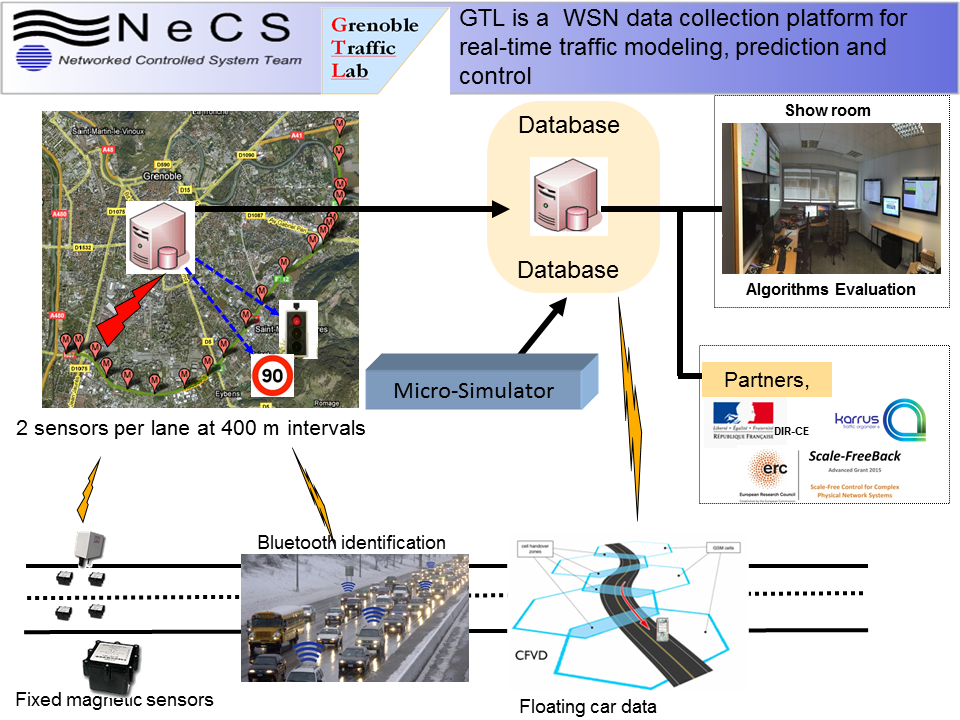
Grenoble Traffic Lab (GTL)
is an experimental platform for real-time collection of traffic
data coming from a dense network of wireless sensors installed in
the south ring of Grenoble, direction east-west from A41 to A480.
The main components of GTL are: 130 magneto-resistive sensors over
the 10.5 km two-lanes highway (26 collection points), a database
and a show-room. Sensors provide macroscopic traffic measurements
such as flow [veh./h], speed [km/h], occupancy [%]. They were put
in place in collaboration with local traffic authorities (DIR-CE)
and Karrus-ITS. The objective of the GTL is to collect dense data
at high frequency. Data are intended for testing new traffic
prediction algorithms, validating traffic mathematical models, and
evaluating on-line traffic indexes.
GTL Operation.
GTL is operated by
NeCS team (a joint
Inria/GIPSA-Lab team-project supported by CNRS, Inria, INPG and
UGA), in collaboration with DIR-CE at Grenoble.
Project status
This project is not maintained anymore, sensors are not connected
and we don't have access to the various datasources anymore.
Current version: 1.1.2
GTL contributors:
- Research engineers: V. Bertrand, R. Piotaix, I. Bellicot, P. Bellemain, A. Andreev
- PhD students: A. Ladino-Lopez, L. León-Ojeda
- Post-docs: E. Lovisari, F. Morbidi
- NeCS staff: C. Canudas-de-Wit, H. Fourati, F. Garin, A. Kibangou
Further information:
- General description of GTL is published in: Grenoble Traffic Lab: an experimental platform for advanced traffic monitoring and control, C. Canudas de Wit, F. Morbidi, L. León Ojeda, A. Y. Kibangou, I. Bellicot, P. Bellemain, IEEE Control Systems Magazine, June 2015.
- Prediction algorithms are published in: Travel time forecasting from clustered time series via optimal fusion strategy, A. Ladino, A. Kibangou, H. Fourati, C. Canudas-de-Wit, European Control Conference 2016, Jun 2016, Aalborg, Denmark.
- An overview of how prediction algorithms worked and the obtained results can be found at NeCS website
- In the scope of the ERC project Scale-Freeback, the team has also created a version of the GTL covering the whole city of Grenoble (and a bit more). The website is accessible here: GTL-Ville.
Acknowledgements:
- Equipment and human resources of the project have received funding from several sources: UGA, HYCON2, MoCoPo, SPEEDD, ERC-AdG Scale-FreeBack, and the Inria DTI program (ADT).
Contacts:
- Scientific contact: carlos.canudas-de-wit@gipsa-lab.fr
Data download
We gladly share the data we gather from our sensors to partners
interested in using it for research or experiments purposes.
Imputed data from January 2019
can be openly downloaded here
.
We provide data for occupancy, counting and
average speed aggregated over 5 minutes for each section
of the rocade (total 21 + 4 queues).
This data is computed from the raw data and the missing data is
corrected by our algorithms.

